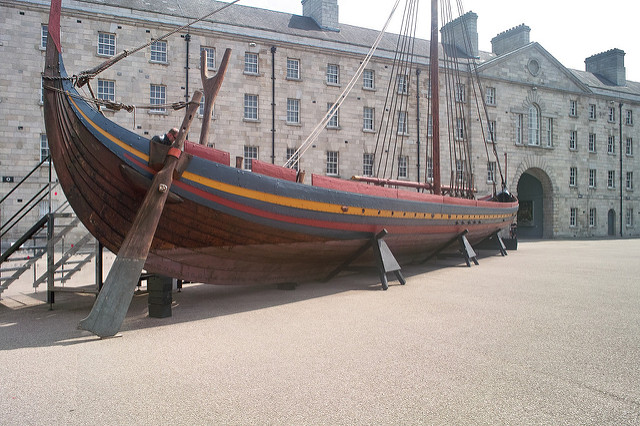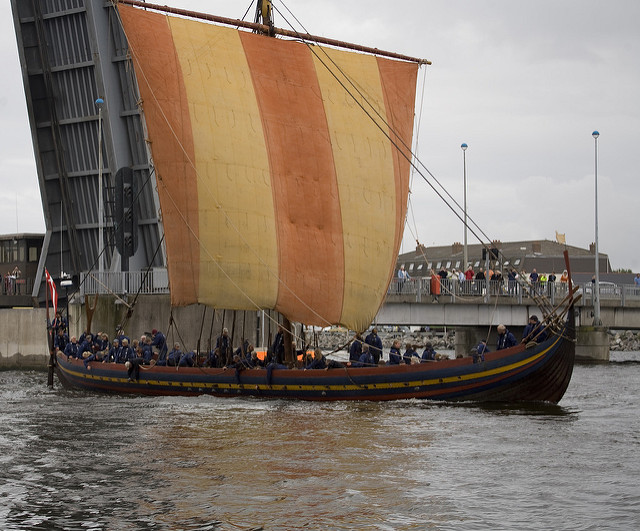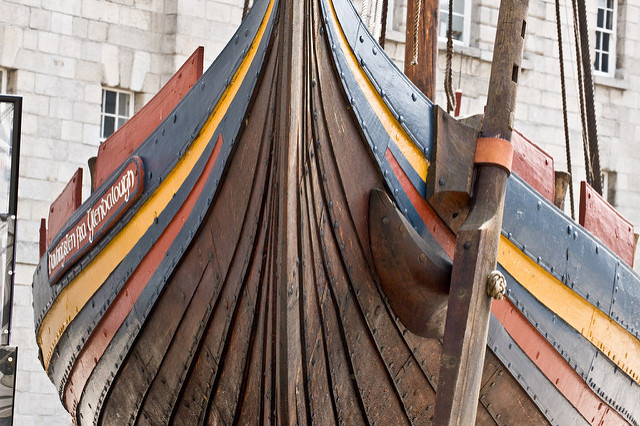
This is another in my series of posts on ancient finances.
Let’s ponder how much time it would take to construct a Viking longship and consider how much of an investment that would be for a community. Any way you look at this, a longship is a major capital asset.
One estimate of time to build a longship
Philip Line, in his book The Vikings and Their Enemies – Warfare in Northern Europe, 750 -1100 written in 2014, provides one framework for the investment in a longship.
I’ll quote and then expand his comment on page 51:
“Experimental archaeologists have estimated that 40,000 working hours may have been needed to produce all the components of a 30-meter longship, consuming the surplus production of 100 persons for a year.”
Surplus production in the Viking context would be the amount of time not needed for subsistence living. In other words the amount of effort a warrior would have after raising enough food to feed his family with enough left over to survive the next winter.
If 40,000 hours is enough time for 100 warriors, that would be 400 hours each. Let’s assume that would be spread over a year except for my assumption that during the worst three months of winter no construction could be done. Since we are talking rough numbers let’s spread that 400 hours over nine months, which would be 44 hours a month, which would be about 11 hours a week.
So 100 warriors working 11 hours a week for 9 months would be needed to construct a longship.
Based on the next article I’ll discuss, a 30 meter longship would have about 30 pairs of oars for 60 oarsmen with total capacity of carrying 80 or 100 passengers.
So in very rough terms, the author is suggesting one longship would take about 100 workers a year to construct. Since that is the count of the passengers that would be sent out on a longship, I’ll assume that corresponds to a village or area under the yarl’s control who would send out a worship.
A community that large could take a year to construct a ship and then send a crew out the next year.
(The footnote citation for the author’s information is not the following report.)

Actual time to build a replica longship
A delightful website, which is not been updated since about 2010, describes construction of a replica longship. All the photos in this post are of that ship.
The Viking Today Magazine website describes construction of the longship Sea Stallion.
The ship was built from 2000 through 2005. Its length is 29.4 m, width 3.8 m, and depth of 1.0 m. It weighs in at 9.2 tons with 6 ton cargo capacity. It was designed for a crew of 60, meaning 30 oars on each side. Maximum load is between 80 and 100 people.
Construction narrative at the website provides delightful background on the project. The team used Viking era construction techniques to the maximum extent possible. That means they split logs instead of sawing them. They climbed to the top of oak trees and cut the curved branches off the top so the branches would not be crushed when the tree was felled.
The ship required 14 large oak trees, each measuring 3 feet in diameter.
The construction team consisted of eight shipbuilders and an apprentice. Estimated time of construction was between 23,000 and 24,000 hours.
Website estimates it would have taken 28,000 hours for Vikings to construct this ship. Their estimate is construction would have taken six months.
Let’s work with that number.
- 28,000 hours
- / 6 months – construction time
- = 4,667 hours per month
- / 60 hours – my assumption for standard work week
- / 4 weeks per month
- = 19 full-time workers putting in 60 hour weeks
From another direction, if workers had 10 hours a week of surplus production it would take 116 workers 6 months to build the longship.
I’ll work with assumptions from another direction.
I will assume a yarl so rich from previous raids that he is able to afford hiring the work in order to get back to raiding.
I’ll assume the standard workweek was 10 hours a day at six days a week. That is the normal work schedule for those people around the world until around 100 years ago or less.
With those assumptions here is an estimate of construction time:
- 28,000 – estimated total time
- / 60 hours per week – my assumption for a standard workweek
- = 467 workweeks
- = 9 work years – assuming 52 weeks a year
We can spread that out in a lot of different ways. Let’s assume that even this rich yarl can hire the work, warriors can’t spend full-time on construction because even though they would have enough money to buy food they would still need to tend to their farms. So I will assume workers can only get in two weeks a month.
So that gives the next step in the calculation:
- 467 workweeks
- / 2 weeks of work a month per hired worker
- = 233 worker-months
- / 100 –let’s assume the number of workers in the area subject to the yarl’s control is roughly comparable to the number of warriors that will be on the longship.
- = 2.5 months – my wild guess on how fast a yarl construct a longship with hiring the workers for two weeks a month
With my string of assumptions, a yarl could build one boat, or perhaps two boats a year. On the other hand having 100 workers spending half the time means there would have to be a lot of extra grain available in the area so this would probably only be possible if the population the area was several hundred farms.
Now let’s work with what the Sea Stallion’s shipbuilder estimates of what a Viking construction team would look like.
He estimates there would be 10 shipbuilders and 5 unskilled workers. Another 20 men would be chopping down the trees, splitting the wood, and cleaving planks. That is a construction crew of 35.

So, let’s do some calculations:
- 28,000 hours – estimated construction time
- 35 man crew
- * 50 hours per week – even though a work week would have been 6 days, I’ll assume the men had do so some work on their farm
- = 1,750 – hours per week
- = 16 weeks – construction time
- = 4 months – construction time
Since I’m looking at construction time from multiple directions, I won’t try to reconciled that calculation with the shipbuilder’s estimate that construction would take 6 months.
For that size of a crew with that specialization with coordination amongst them to stay productive would obviously require hiring them full-time. At least that would be my easy assumption. That means a rich yarl would have to fund the project, pay with grain or silver.
Such a yarl could crank out a longship in 4 months. I wonder if he could push through 2 longships a year between winters?
Moving those numbers around as you wish still leaves the rough picture that an area large enough to send out a fully staffed longship would probably be able to build a ship during a season when they would otherwise be out raiding.
Point estimates of construction time
From these two articles here are the estimates of construction time:
- 22,000-24,000 hours – estimated time to build the replica Sea Stallion
- 28,000 hours – estimated time for Vikings to build a ship equivalent to the Sea Stallion
- 40,000 hours – estimate of time for Vikings to build a 30 m longship
Estimates for calendar time:
- 2.5 months for 100 workers hired to work two weeks a month
- 4 months with hiring a skilled crew of 35
- 6 months – Sea Stallion shipbuilder’s estimate for a Viking crew
- Surplus productivity of 100 people for a year
No matter which estimate you use, it is obvious building a longship was a massive investment.

Imagine the investment for a large raiding party
Now, to further stretch your brain, consider the investment needed to set to sea a raiding party of 10 or 20 longships.
Ponder the massive investment for a 120 ship raid on Paris.
I think the time estimates are being calculated by today’s human beings ability the vikings were a much stronger breed so it figures they were able to accomplish more in less time even though their tools weren’t as good as our tool of today. I also think they were far more motivated also they may have had better and more knowledge of ship building of their era.
Hi Mike:
Great points. Hardy farm workers motivated to keep their family from starving to death probably could sustain their efforts a whole lot longer than me.
I’ve moved my discussion of the Vikings and other ancient finance topics to a new blog, Ancient Finances.
In fact, just today I added a comparison of the time to build a longship to the time to build a B-17 heavy bomber early in WWII. Check out One frame of reference for comparing time to construct large projects if you wish.
Thanks for reading and taking the time to comment.
Jim
I am researching the period of 1070 AD when Willam the Conquerer was still trying to keep his newly won throne. 300 Danish ships arrived on the Humber that year, and I am trying to work out the size of the army that would have been there in south yorkshie. A better understanding of the time to build the correct ship to take a hardened battle group, plus equipment to fight the Norman king is of great interest to me .
Hi Bill:
I don’t have any input for your search. Would be quite interesting in anything you learn. Only idea I have (which you probably have already thought about) would be to look at the Viking invasion force led by Harold Hardrada. Or the various attacks by Viking forces on Paris.
Best of luck on your search.
Jim